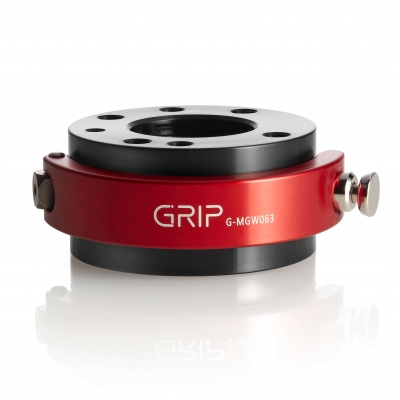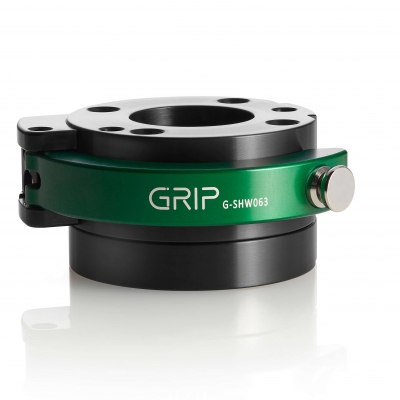What is industrial handling technology?
Industrial Handling technology technology refers to the field of engineering and automation focused on design, analysis, implementation and application of systems used for the handling and processing of materials, workpieces or tools. This includes a variety of devices and machines, such as robotic arms, conveyors, sorting systems and other mechanisms used in production, logistics and many other industrial applications.
GRIP specializes in automatic and manual tool changers (EOAT) standardized feed-throughs and pneumatic grippers such as parallel grippers for robots and cobots.
Our innovative solutions in the area of industrial handling technology


Solution first.
Our tool changers are the interface between robot and tool. Therefore, our end of arm tool changers must meet the stringent requirements of high-quality robot technology.
GET YOUR GRIP ON.
It’s as simple as that.
Increase your productivity with intelligent industrial handling technology from GRIP
The applications for industrial handling technology are diverse and range from the automotive industry, where it is used for tasks such as welding, painting or assembly, to the food industry, where it is used for sorting, packaging and transporting products. GRIP industrial handling technology integrates the most advanced technologies.
The main functions of handling technology in robotics are:
- Cost efficiency and increased productivity: In the long term, industrial handling technology reduces costs and increases productivity by shortening throughput times and by ensuring consistent high product quality.
- Quality control: Some robots are used specifically for inspection and quality control tasks to ensure compliance with quality standards.
- Automation of industrial handling processes: Robots can automate manual handling tasks. This increases the efficiency and speed of production/assembly processes, and reduces errors.
- Increase precision and repeatability: Robots are able to perform tasks with high precision and consistent quality. This is particularly important in areas such as electronics assembly, welding and precision manufacturing.
- Improve worker safety: Industrial handling technology can be utilized to perform dangerous, repetitive or ergonomically awkward tasks, reducing the risk of injury to employees.
Our contribution to your productivity: tool changers (EOAT) and grippers for robots
GRIP specializes in intelligent tool changers (EOAT) and robotic grippers. Our tool changer systems significantly improve the functionality and increase the possibilities of robots in industrial handling technology applications. This helps increase productivity and flexibility in automated manufacturing and production environments.
- Increased flexibility through easy tool changing
- Reduced downtimes thanks to automatic tool changing
- Processes are performed with the highest level of precision
- Safe tool change of heavy or potentially dangerous tools
Areas of application for industrial handling technology in industrial robotics
Industrial handling technology in industrial robotics is used in a variety of industries and applications. Some of the most important areas of application are:
- Plastics and metal processing: In these industries, robots are used for tasks such as injection molding, milling, drilling, cutting and bending.
- Heavy Industry: In industries such as steel and metal manufacturing, robots are used for heavy materials handling, welding, cutting, and assembly tasks.
- Healthcare and medical technology: Robots are used in the production of medical devices, in laboratories for handling samples and in research for precise and repetitive tasks.
- Construction industry: Robots are used in construction for tasks such as welding, cutting, fastening and even 3D printing of building structures.
- Recycling and waste management: Robots are used to sort waste and recyclable materials in order to increase efficiency and protect human workers from hazardous materials.
- Automotive industry: In automotive manufacturing, robots are used for a range of tasks including welding, painting, assembly and handling heavy components. Robots can perform repetitive tasks very precisely, which is crucial in the mass production of vehicles.
- Electronics manufacturing: In the electronics industry, robots are used for precise and delicate tasks such as placing components on circuit boards, soldering, testing and packaging.
- Food and beverage industry: Robots are used for sorting, packaging, palletizing and the labeling of food and beverages. Special modifications are often necessary in order to meet hygienic requirements.
- Pharmaceutical industry: In the pharmaceutical industry, robots are used for high accuracy and contamination protected tasks, such as mixing chemicals, filling tablets, packaging and labeling medicines.
- Logistics and warehousing: Robots are used for sorting, packing, picking and palletizing of goods. They increase efficiency in warehouses and distribution centers.
News
GRIP & OXFAM
We are committed!
EWe take great pleasure in being a part of the @OXFAM network. OXFAM was founded to support the women and men, [...]
Learn MoreNeven Subotic Foundation: GRIP collects donations on its 30th anniversary
We say thanks! Especially to our guests, who made generous donations to the Neven Subotic Foundation [...]
Learn MoreFH Dortmund - University of Applied Science and Arts meets GRIP:
We opened the doors to GRIP in order to give the students from the FH Dortmund University of Applied Sciences and Arts [...]
Learn More30 years of GRIP: We celebrate our anniversary and say thank you!
On 24 May 2019 we celebrated our 30th anniversary on the company premises. Over 200 invited guests, including business partners, representatives from politics and business, friends [...]
Learn More

